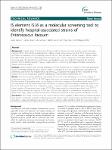IS element IS16 as a molecular screening tool to identify hospital-associated strains of Enterococcus faecium
Werner, Guido
Fleige, Carola
Geringer, Uta
Schaik, Willem van
Klare, Ingo
Witte, Wolfgang
Background: Hospital strains of Enterococcus faecium could be characterized and typed by various molecular methods (MLST, AFLP, MLVA) and allocated to a distinct clonal complex known as MLST CC17. However, these techniques are laborious, time-consuming and cost-intensive. Our aim was to identify hospital E. faecium strains and differentiate them from colonizing and animal variants by a simple, inexpensive and reliable PCR-based screening assay. We describe here performance and predictive value of a single PCR detecting the insertion element, IS16, to identify hospital E. faecium isolates within a collection of 260 strains of hospital, animal and human commensal origins. Methods: Specific primers were selected amplifying a 547-bp fragment of IS16. Presence of IS16 was determined by PCR screenings among the 260 E. faecium isolates. Distribution of IS16 was compared with a prevalence of commonly used markers for hospital strains, esp and hylEfm. All isolates were typed by MLST and partly by PFGE. Location of IS16 was analysed by Southern hybridization of plasmid and chromosomal DNA. Results: IS16 was exclusively distributed only among 155 invasive strains belonging to the clonal complex of hospital-associated strains (“CC17”; 28 MLST types) and various vancomycin resistance genotypes (vanA/B/negative). The five invasive IS16-negative strains did not belong to the clonal complex of hospital-associated strains (CC17). IS16 was absent in all but three isolates from 100 livestock, food-associated and human commensal strains (“non- CC17”; 64 MLST types). The three IS16-positive human commensal isolates revealed MLST types belonging to the clonal complex of hospital-associated strains (CC17). The values predicting a hospital-associated strain (“CC17”) deduced from presence and absence of IS16 was 100% and thus superior to screening for the presence of esp (66%) and/or hylEfm (46%). Southern hybridizations revealed chromosomal as well as plasmid localization of IS16. Conclusions: This simple screening assay for insertion element IS16 is capable of differentiating hospital-associated from human commensal, livestock- and food-associated E. faecium strains and thus allows predicting the epidemic strengths or supposed pathogenic potential of a given E. faecium isolate identified within the nosocomial setting.
Dateien zu dieser Publikation
Keine Lizenzangabe

